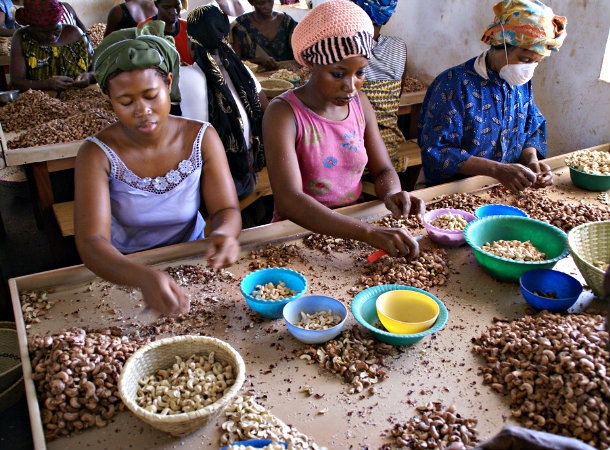Salty-snack junkies, the lactose-intolerant and lovers of Asian food are providing an economic boost for farmers in the northern provinces of Ivory Coast.
The West African country is poised to surpass India as the world’s top grower of cashews. Ivory Coast output has tripled in the past decade, including a jump after the civil war ended in 2011, industry data show. At the same time, prices have rallied as global exports surged along with rising consumption in the U.S., China and India. Long a staple in Asian cooking, the nut increasingly is eaten raw as a snack, and companies like WhiteWave Foods Co. use it to make non-dairy beverages and ice cream.
While people still consume far more peanuts — not technically a nut but treated like one — cashews have become a relative bargain among tree nuts such as pistachios, walnuts and hazelnuts. Almonds surged to records over the past two years during a prolonged drought in California, the biggest grower. Ivory Coast, already the world’s top cocoa exporter, saw the value of its cashew shipments rise almost 50 percent this year to become the nation’s second-most valuable crop.
“Cashew nuts are now the cheapest tree nuts on the market,” Pierre Ricau, an agriculture market analyst at N’Kalô Market Intelligence Services of Rongead, a non-profit providing agriculture assistance in developing countries, said in an interview from Lyon, France. “The snack market keeps developing, but the industry has the wind in its sails when it comes to ingredient usage.”
Almonds, Pistachios
The global cashew market last year was valued at $4.69 billion, compared with $8.32 billion for almonds, $7.33 billion for pistachios, and $6.45 billion for walnuts, according to the International Nut & Dried Fruit Council. Rising incomes in the emerging economies of Asia are a major driver of cashew demand, especially in India, where the nut is ground to a paste for curries and sweets. Demand in the country, which also processes raw cashews for export, more than doubled to 240,000 metric tons of kernels since 2004, according to the African Cashew Initiative in Accra, Ghana. In China, purchases reached 50,000 tons, up from almost nothing a decade ago.
“The market has undergone huge change,” said Rita Weidinger, executive director at the ACI. “The production cannot keep up, meaning there is limited stock available.”
Encroaching Sahara
Cashews aren’t native to Ivory Coast. Trees were imported in the 1960s to reforest the arid northern provinces to prevent the encroaching Sahara desert. They were mostly ignored as a commercial crop until the 1990s, when impoverished northern farmers sought alternatives to soil-damaging crops like cotton and yams. Cocoa is grown mostly in the south.
Expansion of the cashew industry has aided economic recovery following a decade-long civil war that divided a rebel- held north from the government-controlled south. A disputed election in 2010 sparked five months of violence and 3,000 deaths. Since 2011, the economy expanded 9 percent annually on average, and the government is targeting 10 percent this year.
“Cashews give hope to the north,” Malamine Sanogo, head of the industry regulator, the Cashew & Cotton Council, said in an interview from Abidjan. “Everybody recognizes that living conditions have improved.”
Ivory Coast production reached 625,000 tons of cashews in shells as of June 30, compared with 185,000 tons in 2005, council data show. Next year, the country aims to produce 700,000 tons and pass India by 2017, Sanogo said. The country still doesn’t have much processing capacity, so it ships mostly nuts in shells, which are removed at plants in Asia and then sold as kernels domestically or re-exported.
Prices paid to farmers averaged 410 CFA francs (69 cents) per kilo in 2015, up 37 percent from the previous year. The rally helped boost export earnings from cashews to 327 billion CFA francs in the season that ended this June, about 50 percent more a year earlier, government data show.
Nalourou Kone, a 47-year-old farmer in the northern town of Dianra, says the cashew money is changing how people live. Villagers are buying motorcycles instead of bicycles and houses made of brick rather than straw. His 10-hectare (25-acre) farm earned 5.2 million CFA Francs this year, triple what he got in 2010, and now he’s planning to expand by 20 hectares.
“It has changed many things in my life,” said Kone, who used to drive tractors for rice farms before he started growing cashews. “It has helped me get my children to school and build a small house.”













